| Listing 1 - 10 of 41 | << page >> |
Sort by
|

ISBN: 1576750736 9781576750735 1583763910 9781583763919 Year: 1999 Publisher: San Francisco, Calif. : Berrett-Koehler Publishers,
Abstract | Keywords | Export | Availability | Bookmark
 Loading...
Loading...Choose an application
- Reference Manager
- EndNote
- RefWorks (Direct export to RefWorks)
Employee retention. --- Labor turnover. --- Employee retention --- Labor turnover --- Marketing & Sales --- Commerce --- Business & Economics --- Retention of employees --- Personnel management --- Employee turnover --- Turnover of labor --- Labor mobility
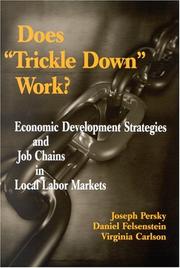
ISBN: 141754998X 088099309X 9781417549986 9780880993081 0880993081 9780880993098 Year: 2003 Publisher: Kalamazoo : W. E. Upjohn Institute for Employment Research,
Abstract | Keywords | Export | Availability | Bookmark
 Loading...
Loading...Choose an application
- Reference Manager
- EndNote
- RefWorks (Direct export to RefWorks)
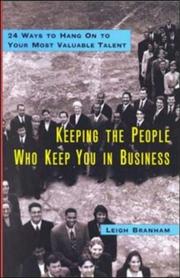
ISBN: 0814425380 0814405975 9780814425381 Year: 2001 Publisher: New York AMACOM
Abstract | Keywords | Export | Availability | Bookmark
 Loading...
Loading...Choose an application
- Reference Manager
- EndNote
- RefWorks (Direct export to RefWorks)
Employee retention. --- Labor turnover. --- Employee turnover --- Turnover of labor --- Retention of employees --- Personnel management --- Labor mobility
Book
ISBN: 1443884219 9781443884211 9781443876025 144387602X Year: 2015 Publisher: Newcastle upon Tyne, England : Cambridge Scholars Publishing,
Abstract | Keywords | Export | Availability | Bookmark
 Loading...
Loading...Choose an application
- Reference Manager
- EndNote
- RefWorks (Direct export to RefWorks)
The problem of migration is a prime example of a subject that requires the skills and approaches of scholars from several disciplines, such as anthropology, demography, economics, sociology, law, political science, and history. This book explores the importance of historical investigation into migration, which can be traced back to the pre-modern period. It continues to be an important socio-economic phenomenon in most parts of the world, though, more than the internal movement of people, the international angle has captured the global imagination of the scholars interested in migration studie
Migration, Internal --- Internal migration --- Mobility --- Population geography --- Internal migrants --- Labor mobility --- Mobility, Labor --- Labor supply --- Labor turnover --- History --- E-books
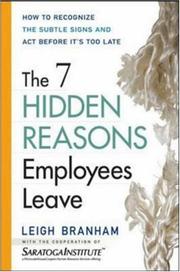
ISBN: 0814408516 9786611126308 1281126306 0814428622 9780814428627 9780814408513 9781281126306 6611126309 Year: 2005 Publisher: New York American Management Association
Abstract | Keywords | Export | Availability | Bookmark
 Loading...
Loading...Choose an application
- Reference Manager
- EndNote
- RefWorks (Direct export to RefWorks)
What is so bad about your company that would make people quit without a good reason? Find out.
Employee retention. --- Job satisfaction. --- Labor turnover. --- employee retention. --- job satisfaction. --- labor turnover. --- Employee turnover --- Turnover of labor --- Occupational satisfaction --- Work satisfaction --- Retention of employees --- Personnel management --- Labor mobility --- Quality of work life --- Satisfaction --- Job enrichment --- Employee retention --- Job satisfaction --- Labor turnover
Book
ISBN: 9781786354419 1786354411 178635442X 9781786354426 Year: 2017 Publisher: Bingley Emerald
Abstract | Keywords | Export | Availability | Bookmark
 Loading...
Loading...Choose an application
- Reference Manager
- EndNote
- RefWorks (Direct export to RefWorks)
The 2004 reunification of Eastern and Western Europe and the subsequent economic crisis caused a surge in intra-European labour mobility and a profound shift in preceding patterns of migration in Europe. While previous decades of European integration brought very modest cross-border flows of labour, the past decade has engendered the largest European movements of labour in modern time mostly from East to West, but eventually also from South to North. In a situation of record high European unemployment, this has sparked controversy about the very notion of free movement, one of the basic foundations of the European Community, and has unleashed heated debates about the conditions, causes, and consequences of large-scale labour migration for receiving as well as sending societies. Against this background, this volume of Comparative Social Research will contribute to improve our understanding of the drivers, mechanisms, and effects of the past decade's surge in cross-border labour mobility and work related migration within Europe.
E-books --- Labor mobility --- Mobility, Labor --- Migration, Internal --- Labor supply --- Labor turnover --- Sociology of work --- Migration. Refugees --- Europe --- EU countries --- Euroland --- Business & Economics --- Sociology: work & labour. --- Labor.
Book
ISBN: 1760463078 176046306X Year: 2019 Publisher: ANU Press
Abstract | Keywords | Export | Availability | Bookmark
 Loading...
Loading...Choose an application
- Reference Manager
- EndNote
- RefWorks (Direct export to RefWorks)
"Today, increases of so-called ‘low-skilled’ and temporary labour migrations of Pacific Islanders to Australia occur alongside calls for Indigenous people to ‘orbit’ from remote communities in search of employment opportunities. These trends reflect the persistent neoliberalism within contemporary Australia, as well as the effects of structural dynamics within the global agriculture and resource extractive industries. They also unfold within the context of long and troubled histories of Australian colonialism, and of complexes of race, labour and mobility that reverberate through that history and into the present. The contemporary labour of Pacific Islanders in the horticultural industry has sinister historical echoes in the ‘blackbirding’ of South Sea Islanders to work on sugar plantations in New South Wales and Queensland in the late nineteenth and early twentieth centuries, as well as in wider patterns of labour, trade and colonisation across the Pacific region. The antecedents of contemporary Indigenous labour mobility, meanwhile, include forms of unwaged and highly exploitative labouring on government settlements, missions, pastoral stations and in the pearling industry. For both Pacific Islanders and Indigenous people, though, labour mobilities past and present also include agentive and purposeful migrations, reflective of rich cultures and histories of mobility, as well as of forces that compel both movement and immobility.Drawing together historians, anthropologists, sociologists and geographers, this book critically explores experiences of labour mobility by Indigenous peoples and Pacific Islanders, including Māori, within Australia. Locating these new expressions of labour mobility within historical patterns of movement, contributors interrogate the contours and continuities of Australian coloniality in its diverse and interconnected expressions."
Pacific Islanders --- Indigenous people --- Labor mobility --- Mobility, Labor --- Migration, Internal --- Labor supply --- Labor turnover --- Oceanians --- Ethnology --- Indigenous peoples --- work --- labour --- migration --- Australia --- Pacific
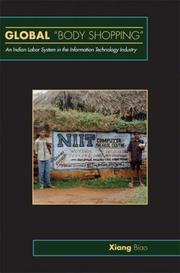
ISBN: 9786613101471 1400836336 1283101475 9781400836338 9780691118512 0691118515 9780691118529 0691118523 Year: 2011 Publisher: Princeton, NJ
Abstract | Keywords | Export | Availability | Bookmark
 Loading...
Loading...Choose an application
- Reference Manager
- EndNote
- RefWorks (Direct export to RefWorks)
How can America's information technology (IT) industry predict serious labor shortages while at the same time laying off tens of thousands of employees annually? The answer is the industry's flexible labor management system--a flexibility widely regarded as the modus operandi of global capitalism today. Global "Body Shopping" explores how flexibility and uncertainty in the IT labor market are constructed and sustained through concrete human actions. Drawing on in-depth field research in southern India and in Australia, and folding an ethnography into a political economy examination, Xiang Biao offers a richly detailed analysis of the India-based global labor management practice known as "body shopping." In this practice, a group of consultants--body shops--in different countries works together to recruit IT workers. Body shops then farm out workers to clients as project-based labor; and upon a project's completion they either place the workers with a different client or "bench" them to await the next placement. Thus, labor is managed globally to serve volatile capital movement. Underpinning this practice are unequal socioeconomic relations on multiple levels. While wealth in the New Economy is created in an increasingly abstract manner, everyday realities--stock markets in New York, benched IT workers in Sydney, dowries in Hyderabad, and women and children in Indian villages--sustain this flexibility.
Labor mobility --- Electronic data processing personnel --- Mobility, Labor --- Migration, Internal --- Labor supply --- Labor turnover --- Computer industry --- Employees --- India --- Emigration and immigration.
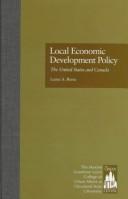
ISBN: 0415868491 1315007398 1136253424 9781136253423 9780415176811 0415176816 9780415178389 041517838X 9780415178297 0415178290 9781315007397 9781136253508 9781136253577 9780415868495 1136253505 Year: 2000 Publisher: London Routledge
Abstract | Keywords | Export | Availability | Bookmark
 Loading...
Loading...Choose an application
- Reference Manager
- EndNote
- RefWorks (Direct export to RefWorks)
First published in 1998. Routledge is an imprint of Taylor & Francis, an informa company.
Labor mobility --- Labor supply --- Labor force --- Labor force participation --- Labor pool --- Work force --- Workforce --- Labor market --- Human capital --- Manpower --- Manpower policy --- Mobility, Labor --- Migration, Internal --- Labor turnover
Book
ISBN: 9780691154510 0691154511 9780691127200 0691127204 9786612569159 1282569155 1400834384 9781400834389 9781282569157 6612569158 Year: 2012 Publisher: Princeton, N.J. Princeton University Press
Abstract | Keywords | Export | Availability | Bookmark
 Loading...
Loading...Choose an application
- Reference Manager
- EndNote
- RefWorks (Direct export to RefWorks)
It is taken for granted in the knowledge economy that companies must employ the most talented performers to compete and succeed. Many firms try to buy stars by luring them away from competitors. But Boris Groysberg shows what an uncertain and disastrous practice this can be. After examining the careers of more than a thousand star analysts at Wall Street investment banks, and conducting more than two hundred frank interviews, Groysberg comes to a striking conclusion: star analysts who change firms suffer an immediate and lasting decline in performance. Their earlier excellence appears to have depended heavily on their former firms' general and proprietary resources, organizational cultures, networks, and colleagues. There are a few exceptions, such as stars who move with their teams and stars who switch to better firms. Female stars also perform better after changing jobs than their male counterparts do. But most stars who switch firms turn out to be meteors, quickly losing luster in their new settings. Groysberg also explores how some Wall Street research departments are successfully growing, retaining, and deploying their own stars. Finally, the book examines how its findings apply to many other occupations, from general managers to football players. Chasing Stars offers profound insights into the fundamental nature of outstanding performance. It also offers practical guidance to individuals on how to manage their careers strategically, and to companies on how to identify, develop, and keep talent.
Labour market --- Private finance --- Investment advisors --- Labor turnover --- -Labor turnover --- -332.60683 --- Employee turnover --- Turnover of labor --- Fund managers (Investment advisors) --- Investment advisers --- Investment counselors --- Investment houses (Investment advisors) --- Investment management firms --- Money managers (Investment advisors) --- Financial planners --- Financial District (New York, N.Y.) --- Wall Street (New York, N.Y.) --- E-books --- Wall Street (New York, N.Y.).
| Listing 1 - 10 of 41 | << page >> |
Sort by
|

 Search
Search Feedback
Feedback About UniCat
About UniCat  Help
Help News
News